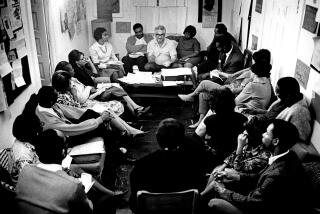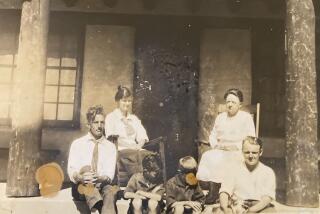Jane Wheelwright, 98; Played Key Role in Breaking Up Historic Hollister Ranch
- Share via
Jane Hollister Wheelwright, a pioneering Jungian analyst and direct descendant of one of California’s great ranching families who played a pivotal role in the breakup of the Central California empire known as Hollister Ranch, died April 27 at a Santa Barbara nursing home after a long illness. She was 98.
Wheelwright was the granddaughter of Col. William Welles Hollister, an Ohio farmer who founded the ranch in the 1860s after making a historic trek across the country.
He created out of five smaller ranches one of California’s largest: a realm of 39,000 acres, including a breathtaking expanse of the coast from Point Conception to beyond Gaviota.
His heir spent most of her life worlds away from the dust and grit of the land. In the 1930s, along with husband Joseph, she became a Jungian analyst -- they were analyzed in Switzerland by Carl Jung himself -- and lived in London and Shanghai before settling in San Francisco.
In the 1940s the Wheelwrights became co-founders of the first Jungian training center in the world, a forerunner of the C.G. Jung Institute of San Francisco.
History books, however, will probably record Jane Hollister Wheelwright as an eloquent steward of the land. When the ranch passed out of family hands in the late 1960s, it was a grand remnant of untamed, early California, little changed since Col. Hollister’s time -- a “fantastic but real world” of rugged terrain, ancient oaks, wild cattle and screaming pumas. Still fiercely guarded by new owners, the present, smaller development called Hollister Ranch remains off-limits to all but an exclusive group of residents and a few plucky surfers.
Wheelwright wrote a passionate account of her relationship to the ranch in a 1988 memoir, “The Ranch Papers,” which is considered a classic of early California history. Praised as a daring work of art by novelist May Sarton, it describes a series of trips Wheelwright took across the ranch on horseback as she pondered its future, a spiritual as well as physical journey with a bittersweet ending.
Her keen portrait of the land, with its observations of the reptilian form of a great gnarled oak to the wild romp of a white coyote, opened a window on a part of California few people had experienced.
“Her writings revealed for her readers the splendor of the wilderness of the Hollister property. It really is amazing, like stepping back in time,” Mark Massara, director of the Sierra Club’s coastal program, who has hiked some of the ranch trails, said this week. He gave Wheelwright a large measure of credit for the preservation of native chaparral and other pristine habitats found on the ranch.
Wheelwright’s grandfather became the first man to drive sheep across the continent to California in 1853, when he led a herd of 5,000 from Ohio to San Diego. In a partnership with a brother and another great ranching family, the Dibblees, he at one time held more than 200,000 acres stretching from Monterey County (where the town of Hollister was named after him) to Santa Barbara.
Wheelwright’s parents, Lottie Steffens and John James Hollister, met in the pioneer class of Stanford University; he dabbled in gold prospecting for a few years; she earned a doctorate in psychology in Germany. Lottie’s brother was Lincoln Steffens, the muckraking journalist who wrote “The Shame of the Cities.”
Wheelwright was born in 1905 at the Steffens Mansion in Sacramento, which later became the Governor’s Mansion. She moved to Mexico with her parents when she was an infant, returning to California when she was about 3 to live at the ranch with her three brothers.
“She could operate a team of horses and a wagon as well as they could,” her son, John, said last week. “I don’t think she realized she was a girl until much later.”
According to one biographical sketch, Wheelwright and her twin, Clinton, pretty much raised themselves. Their busy parents barred them from the grand ranch house during the day, leaving them to roam the pastures, beaches and canyons unsupervised for hours on end.
When Wheelwright was 8, her parents put her on a horse by herself for the long ride to a girls boarding school in Santa Barbara. Thereafter she spent summer vacations on the ranch. Finding that she lacked the proper disposition for college, she dropped out of Bryn Mawr in Pennsylvania after one year and lived in Italy and England with her Uncle Lincoln.
She continued to travel the world with her husband, a writer, after they were married in 1929. A daughter was born in China and a son was born in London.
Joseph Wheelwright died in 1999. Jane Wheelwright is survived by her children, Lynda Wheelwright Schmidt of Brooklin, Me., and John Hollister Wheelwright of Point Reyes Station; three grandchildren, and four great-grandchildren.
The Wheelwrights were passing through Zurich in the late 1930s when they met Jung, who by then had parted from his onetime colleague, Sigmund Freud, to develop his own theory of personality. The Wheelwrights were experiencing marital conflicts and Joseph, having read one of Jung’s papers that he thought precisely described his and his wife’s clashing personality types, decided to call on the Swiss psychoanalyst.
Both were analyzed by Jung. Joseph went to medical school in London and became a psychiatrist. Jane Wheelwright became a lay analyst.
At that time, analysts became Jungians when Jung said they were ready to accept patients for analysis. The Wheelwrights were among a small group of analysts in San Francisco who recognized the need for a more formal process. About 1945, the center they formed “took the very first person into Jungian training,” said Dr. John Beebe, a past president of the C.G. Jung Institute of San Francisco, who received some of his training from Jane Wheelwright.
“She was profoundly ahead of her time,” Beebe said. “She was saying in the 1950s that it was ridiculous to have any kind of prejudice against homosexuality. She worked very hard with lesbian patients.”
She worked with her husband to develop a personality survey that was widely used in the 1940s and 1950s. According to Beebe, it was the earliest paper-and-pencil test of its kind.
She was unusual among Jungians for her practicality and for bringing what Beebe called a “very earthy, authentic female voice” to analytical psychology.
“She would say of someone, ‘Oh, I don’t trust her -- she darts out at you just like a snake.’ She had a very natural imagery when she spoke,” Beebe recalled.
Yet she was not talkative. She was the type, her daughter said, who “didn’t talk unless she had to,” a consequence of growing up on the ranch, where Wheelwright’s father could drive for hours, checking on fences and the whereabouts of workers, without saying one word.
In the 1960s she began to work with terminally ill patients, which led her to write “The Death of a Woman,” which was published in 1981 by St. Martin’s Press. She co-wrote with her daughter “The Long Shore,” another ranch memoir.
Despite those achievements, her years on Hollister Ranch were the most formative, “the central part of me,” she would later write. When her father died in 1961, however, the will and the financial wherewithal to keep it intact began to splinter.
Of Col. Hollister’s seven grandchildren, it was Jane Wheelwright who held the decisive hand: Her father had left her half the shares in the ranch.
“She just loved the ranch more than anything in the world,” her nephew, J. James Hollister III, said Tuesday. “She would have loved to have kept it and run it the way her father ran it. But she felt the pressures of the ranch. The ranch is a lifestyle and doesn’t pay a lot of money. Economically, it wasn’t making sense.”
Owning so much prime land troubled Wheelwright in her later years. Joan Didion, the perceptive interpreter of California, devoted several pages of her recent book, “Where I Was From,” to a critique of Wheelwright’s memoir, finding in Col. Hollister’s only granddaughter a “complicated, even tortured” sense of entitlement. To some critics, if nature was a commodity, the ranch was a monopoly that kept too much of California’ natural wealth in one family’s hands.
Whether to keep or sell the land created great family dissension, with some members aggrieved over its loss, and others dreaming of, as Wheelwright put it, “cash and escape.”
The debate, as she framed it, ranged over the questions of “whether land can belong to anyone, or whether one belongs to the land. We had all shared in the glamour of immense, privately owned land. Whether earned or inherited, it was our mark of distinction.”
The property was divided and changed hands a number of times before the current Hollister Ranch development was formed out of the old coastal tract. Residents of the exclusive gated community of more than 130 hundred-acre parcels have included such entertainment figures as director James Cameron and singer-songwriter Jackson Browne. Wheelwright bought back one parcel, overlooking Point Conception, for her family.
She had been high over Point Conception, in a helicopter, on the day in 1963 when she realized that selling the ranch was the only course. It was her first aerial view of the land that its original owners, the Chumash, had held sacred.
Calling this forbidding promontory the Western Gate, they considered it the point of departure for souls migrating to the next world.
“I could have ridden the ranch forever and never have seen what I did in one instant,” Wheelwright later wrote of her flight over the land. “That ranch had never really been ours. It belonged to a much bigger system than the Hollister family.”
More to Read
Sign up for our Book Club newsletter
Get the latest news, events and more from the Los Angeles Times Book Club, and help us get L.A. reading and talking.
You may occasionally receive promotional content from the Los Angeles Times.











